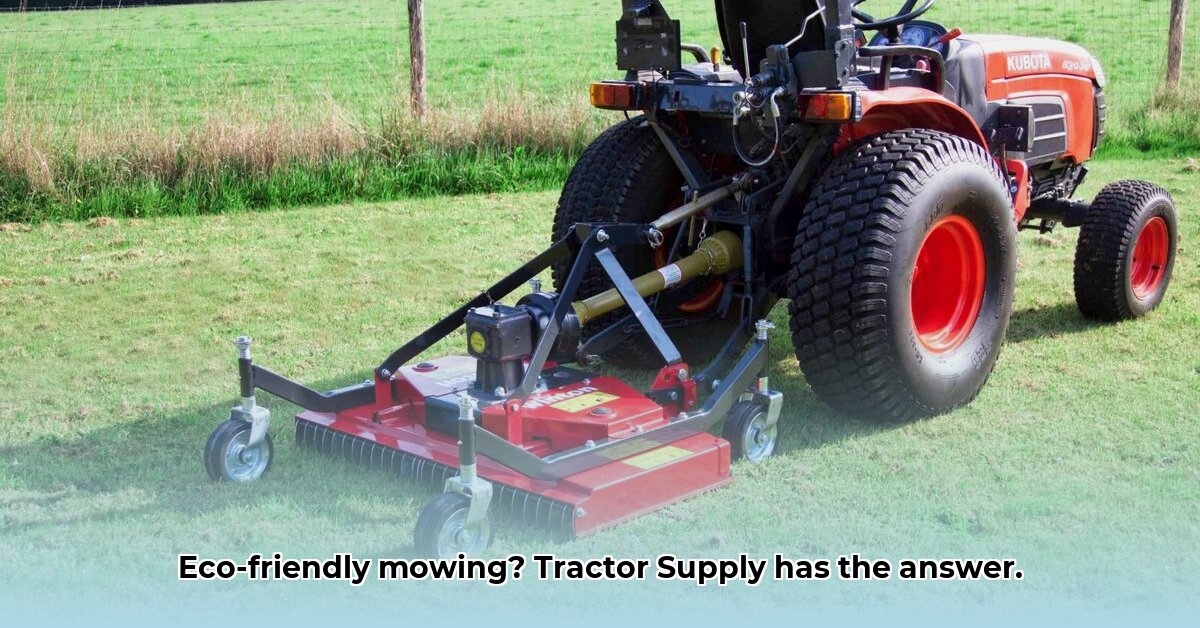
Choosing the right finishing mower can significantly impact the health of your land and the efficiency of your operations. This guide helps you navigate the selection process at Tractor Supply, focusing on both performance and sustainability. Whether you're a large-scale farmer or a homeowner with a sizable lawn, this guide will help you make an informed decision. For more mower options, check out this helpful resource.
Understanding Your Needs: Assessing Your Specific Context
Before diving into mower specifications, consider these key factors:
Acreage: How much land needs mowing? Larger areas necessitate wider cutting widths for efficient operation. Smaller properties can utilize smaller mowers, potentially saving on costs and reducing soil compaction.
Tractor Horsepower: Your tractor's PTO (Power Take-Off) horsepower must match the mower's requirements. Insufficient power leads to strain and inefficient mowing; excessive power is wasteful. Always consult your tractor's owner's manual.
Turf Type: Different grasses require different mowing approaches. Delicate turf benefits from lighter mowers with adjustable cutting heights, while tougher grasses can tolerate more powerful machinery.
Budget: Finish mowers range widely in price. Determine a realistic budget to avoid exceeding your financial limits. Consider the lifetime costs, including maintenance, repairs, and fuel consumption.
Sustainability Goals: Prioritize fuel efficiency, minimal soil compaction, and reduced environmental impact, selecting models with features like rear discharge or fuel-efficient engines.
Key Features for Sustainable Mowing: Prioritizing Efficiency and Environmental Impact
Several mower features directly affect both efficiency and environmental impact:
Cutting Width: Wider cutting widths reduce the number of passes, saving time and fuel. However, wider mowers are often heavier, potentially increasing soil compaction. Find the optimal balance for your needs.
Discharge Type (Rear vs. Side): Rear discharge mowers spread clippings evenly, acting as a natural fertilizer. This reduces reliance on chemical fertilizers, benefiting the environment. Side discharge is suitable for situations where you don't want to use clippings as fertilizer, or where more frequent mowing is necessary.
Engine Type and Fuel Efficiency: While precise fuel efficiency data per acre is difficult to obtain for specific models, consider engine type (gasoline vs. diesel) and size. Smaller engines typically use less fuel and produce fewer emissions, although diesel engines often offer better long-term fuel efficiency. More research on specific models is usually required.
Mower Weight and Tire Type: Heavier mowers increase soil compaction. Wider tires distribute weight more evenly, minimizing this impact.
Maintenance Requirements: Easy-to-maintain mowers with readily available parts reduce long-term costs and minimize downtime.
Tractor Supply Mower Options: A Comparative Overview
Tractor Supply offers a range of finish mowers. The following table provides a hypothetical comparison (replace with actual Tractor Supply models and specifications). Always verify current models and pricing directly with Tractor Supply.
| Model (Example - Check Tractor Supply) | Cutting Width (ft) | Discharge Type | Engine Type | Approximate Weight (lbs) | Estimated Price ($) | Pros | Cons |
|---|---|---|---|---|---|---|---|
| Example Brand X | 5 | Rear | Gasoline | 500 | 500 | Lighter, maneuverable, good for smaller properties | Smaller cutting width, may require more passes |
| Example Brand Y | 6 | Side | Diesel | 700 | 700 | Wider cut, fuel-efficient, durable | Heavier, potentially greater soil compaction |
| Example Brand Z | 7 | Rear | Gasoline | 800 | 900 | Wide cut, potentially quick mowing | Heavier, higher initial cost, potentially higher fuel consumption |
Note: This is a sample comparison. Specifications, pricing, and availability are subject to change. Always consult Tractor Supply's current inventory.
Choosing the Right Tractor: Ensuring Compatibility and Optimal Performance
The tractor's PTO horsepower is crucial. It dictates the size and type of mower it can effectively and safely operate. An underpowered tractor can damage both the tractor and the mower; an overpowered tractor is inefficient.
Sustainable Practices Beyond Equipment: Maximizing the Benefits
Sustainable land management extends beyond equipment choice:
Mowing Height: Taller grass stays healthier and uses water more efficiently.
Blade Sharpness: Sharp blades provide clean cuts that minimize grass damage, reducing disease susceptibility.
Recycling Clippings (Rear Discharge): Use grass clippings as natural fertilizer, reducing chemical fertilizer needs.
Soil Health: Regularly test your soil to maintain optimal nutrient levels.
Mowing Techniques: Avoid mowing when the soil is wet to minimize compaction.
Choosing the right finishing mower involves careful consideration of your specific needs and environmental priorities. This guide helps you find the best balance of efficiency and sustainability to create a healthy and productive landscape, whatever its size.